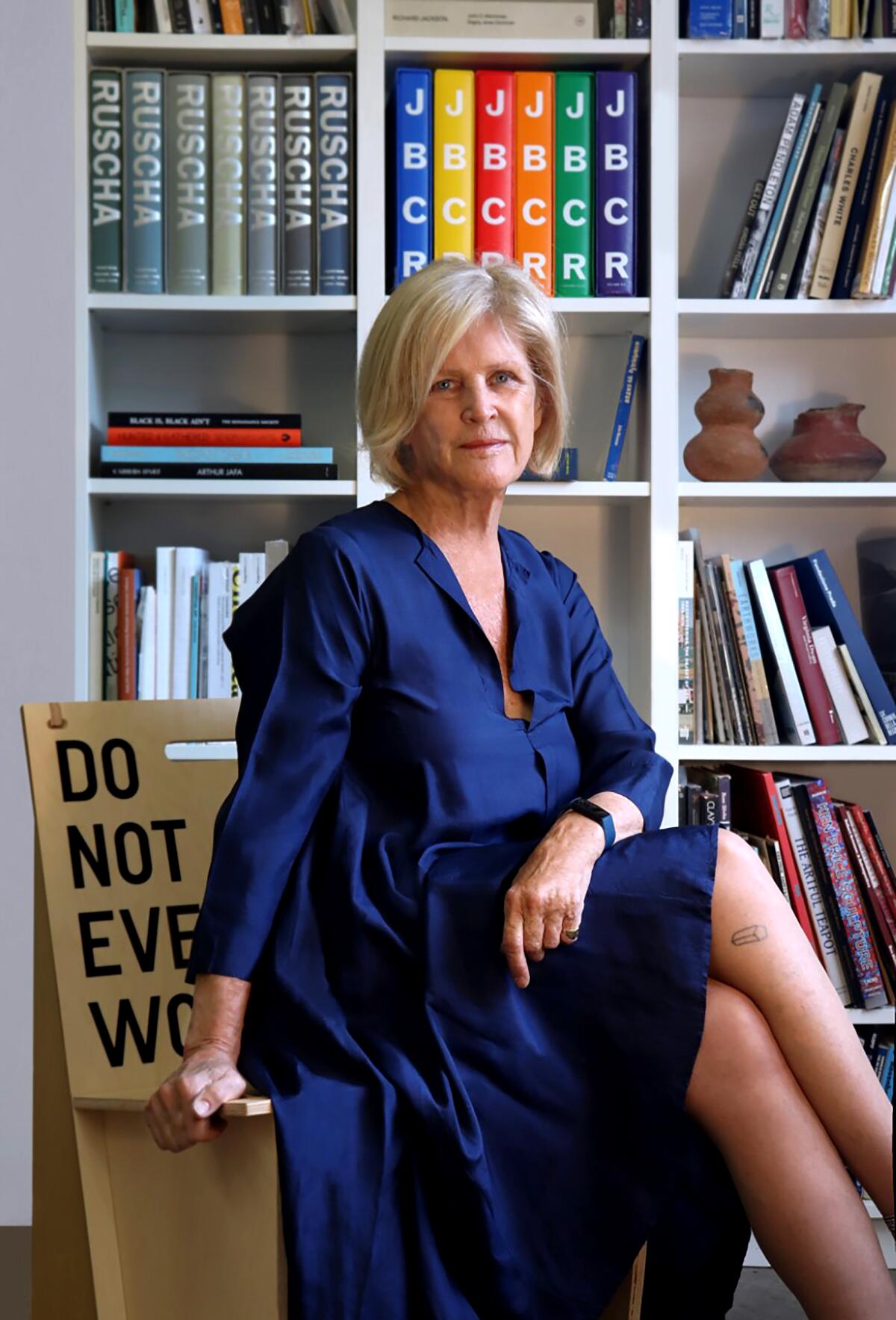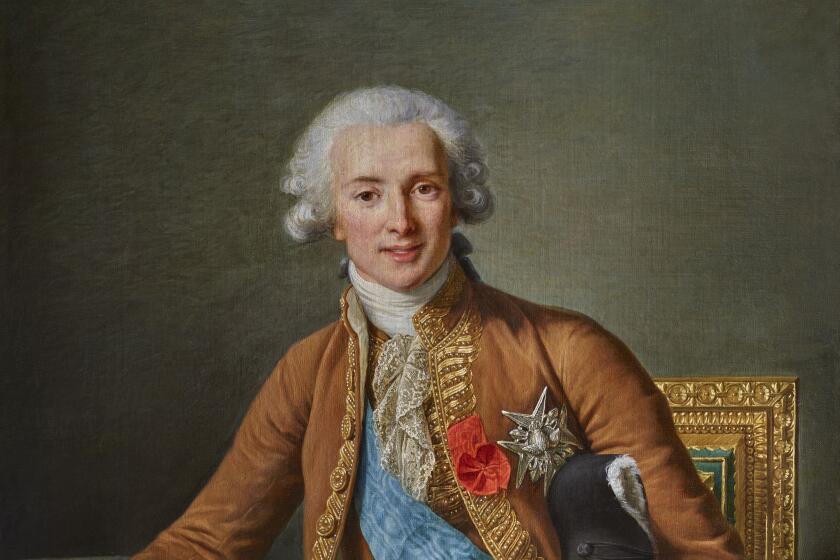Appreciation: Celebrated bookseller and major L.A. art player Dagny Janss Corcoran dies at 77

- Share via
Sometimes it seems as if everyone in Los Angeles has a tattoo. With relative certainty, however, it can be said that nobody in the city has a tattoo quite like the single mark Dagny Janss Corcoran had inscribed in a somewhat unusual place, just beneath and outside her right knee.
The source of the little image is “The 2000 Sculpture” (1992), a vast Minimalist floor arrangement of 2,000 white-plaster rods that would stretch for 1 kilometer if all rods were laid end-to-end. The tattoo, only a few inches long, is a spare linear outline of one rod in the form of a polygon. Placement by her knee was apt, since the location combines flexible joinery with genuflection for Walter De Maria (1935-2013), who created the sculpture. Corcoran compiled a meticulous, 65-page chronology, published to coincide with the exhibition “Walter De Maria: Boxes for Meaningless Work,” newly opened at Houston’s Menil Collection, a labor of love for her friend and favorite artist.
For the record:
8:00 a.m. Nov. 12, 2022An earlier version of this story misidentified the publisher of a new Walter De Maria monograph. The book was published by Gagosian Gallery.
Also just like Dagny: For a Wall Street Journal story last year about the expansion to Paris of Art Catalogues, her celebrated bookstore, she posed for photographer Derek Kinzel in a manner that would advertise her passions as much as pitch her business.
While seated in a simple plywood chair by artist Rirkrit Tiravanija, a sculptural multiple printed on the back in big black letters with the admonishment, “Do Not Ever Work,” her legs are crossed, the skirt of her unfussy blue dress unobtrusively hiked so the tattoo is casually exposed. In front of a bookcase, her familiar blond bob is crowned with two multivolume catalogues raisonnés — scholarly compendiums of two other favorite artists, Edward Ruscha and John Baldessari.
A picture tells many stories to those with the curiosity and wherewithal to read it, and few things gave her more pleasure than that. Corcoran, who died Wednesday in Los Angeles after an aggressive bout with a rapidly spreading multiple myeloma, had been doing it since she was a teenager. Survived by a son, Timothy Corcoran, and brothers Peter Janss and Larry Janss, she was 77. Her death was confirmed by Gregory Evans, a longtime friend and her appointed healthcare agent.
That number, unlike her business, was not something she often willingly advertised. I’d known her for more than 30 years, ever since her first shop opened on the second floor of a powerhouse Santa Monica Boulevard gallery building in West Hollywood, and it always remained a mystery. Downstairs from the shop was a gallery owned by her second husband (now ex), James Corcoran, and another by a pal, influential art dealer Nicholas Wilder, and next door a third would soon open, operated by Betty Asher and Patricia Faure. I lived around the corner, and there was no more congenial place to stop in to observe how to not ever work.
Art Catalogues is her unique legacy, an extraordinary compendium of gallery and museum monographs and other books on hundreds, and maybe thousands, of artists. (Her stock grew to about 10,000 items.) Some were rare, others were signed by the artist or writer, and all were worth having. She considered art books to be cousins to art objects.
Occasionally, Corcoran would team with an artist to produce an actual multiple, as she did this year with Bruce Nauman, whose book-themed “Journal” is a holographic digital artwork made for an iPad. Mail order is the biggest driver of sales, with clients from Australia to England, while university and public libraries also come calling. Corcoran was an endless font of informed opinion if you were on the hunt for something special. She even assembled full libraries for serious art collectors.
Commentary: Huntington museum lands a smashing gift, painted by court artist to Marie Antoinette
The Ahmanson Foundation’s first major European art gift to the Huntington is a portrait by Élisabeth Louise Vigée Le Brun.
The business began by accident. Her father, third-generation California land developer Edwin Janss Jr. (Thousand Oaks, plus chunks of Aspen, Colo., and Sun Valley, Idaho) and a proud member of Richard Nixon’s fabled “enemies list,” had begun collecting contemporary art. Walter Hopps, past director of the Pasadena Museum of Modern Art, gave advice. When the museum hit the financial skids in 1974 and Norton Simon took control of the place, Hopps encouraged Dagny to hurry over and salvage books from the museum’s library of recent art, which Simon was poised to discard. With a couple hundred volumes suddenly in hand, opening an art bookstore soon seemed a logical step.
Since 1977, the store has operated in at least half a dozen locations, including at the Museum of Contemporary Art and the Los Angeles County Museum of Art, as well as an old barn of a building in Springvale, the Southern Sierra foothill town where she relocated during a third marriage, long since ended, to rancher John Grant. In addition to an essential website, current locations are in Culver City and Paris — a concurrence she adored — the latter under the auspices of the venerable Marian Goodman Gallery.
The future of the business has yet to be determined. Since Dagny was Art Catalogues, it will likely unwind. Her physical shops were art world gathering places as much as businesses, and she ran them as a kind of deeply informed hostess.
She was great at that.
Depending on the occasion, Corcoran could assemble 20, 60, sometimes even as many as 100 art world people for dinner, conversation or a casual celebration, all in an 1,100-square-foot one-bedroom condominium in a Century City high-rise. Guests would tightly wrap around the big dinner table in the center of the room, pack into a small sitting area nearby, stand cheek-by-jowl in the entryway and bedroom, spill out onto small terraces over the driveway or swimming pool far below and, if need be, balance on the edge of a bathtub, steadying heaping plates of food on their laps.
David Hockney was allowed to smoke — surreptitiously.
Silently observing the convivial scene was an Andy Warhol silkscreen portrait of Chairman Mao, made in the early 1970s after Nixon’s paradoxical sojourn to Communist China (and perhaps a silent salute to her dad), hanging on a single wall covered in the same banana-leaf wallpaper that adorns the corridors of the Beverly Hills Hotel. Nobody minded the crush. The abundant fare would come from Corcoran’s impossibly tiny kitchen, most of it prepared on the spot by the hostess in an all-day cooking marathon, then laid out on the counter for a serve-yourself buffet. A bartender helped.
Inevitably, there would be people you hadn’t met before but wanted to meet again. (“You can’t have a good dinner party with a bunch of wet blankets,” she once told interviewer Hunter Drohojowska-Philp.) A Christmas Eve gathering might assemble irreligious friends, a meet-the-artist event at the shop might end up twice the size at her place. After my own wedding to Fernando Sarthou, following a whirlwind 33-year engagement, she insisted on hosting a proper reception; unable to locate appropriate table décor for the new phenomenon of same-sex marriage, she made do with a cluster of small souvenir Oscar statuettes.
Corcoran was a bibliophile who didn’t hoard books but who delighted in knowing what she could about those within her sphere of Modern art interests and making them available to others. She did the same with people. It’s a vital mix that doesn’t come along often, and one that will be sorely missed.
More to Read
The biggest entertainment stories
Get our big stories about Hollywood, film, television, music, arts, culture and more right in your inbox as soon as they publish.
You may occasionally receive promotional content from the Los Angeles Times.












